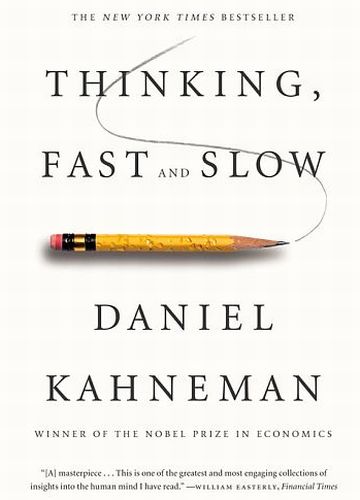Thinking, Fast and Slow is a masterpiece written by the Nobel Laureate, Daniel Kahneman; in here, he is targeting human irrationality. He starts with the book by naming the two parts of a brain as System I and System II, where System I, is the ‘intuition part’, which operates automatically most of the times and is without logic; while System II denotes effortful mental activity, involving logics. It is because of the System I that humans suffer from cognitive biases or the unconscious errors that leads one to jump onto wrong conclusions.
Every chapter is sodden with extremely lucid first hand experiments that the author along with his friend and colleague Amos Tversky had performed over the years and the learning that the duo managed to reach. Although Kahneman did gave credit to Taleb’s book The black Swan (chapter-19) where he talk about “Narrative Fallacy” and “halo effect” but I feel that the book has also some inkling on Levitt and Dubner’s Freakonomics especially when he is referring to the flaws in statistics and projections, in companies, enterprises including stock market, which one can avert by placing the element of buffer in the scenario.
Keeping flaws in (human) reasoning on one side and juxtaposing the sense of (human) confidence on the other scale, the book has been able to ignite the hidden skepticism amongst many individuals. I am sure there would be some changes in the rationale of individuals who have gone for, at least, one serious reading of this fantastic book.
(Spoiler alert!)
Part I
First portion of the book is dedicated to the two little agents, System I and System II. System I is quick, requires less or no effort, after gaining a particular skill set, it generates intuition, focuses only on what it can see as it cannot render the other side, tries to reach to the conclusion as soon as possible. On the other hand, System II is deliberate, rational but lazy. It involves huge bandwidth of effort and unlike System I it is slow.
Part II
With numerous experiments and effects, the writer stresses that how easily humans are able to condone the analytical machinery within the brain, only because of a simple reason that it is a pattern seeker by nature. And it is because of this, we are not able to think statistically.
Regression to the mean is another interesting yardstick put forth by the author. Very deftly, he insinuates that it is to be noted in particular observation and not measured in samples.
Taming intuition is one of the most interesting parts of the book. In here, Kahneman says that betting on intuition all the time is not a good idea. Since intuition takes cues from the previous experiences, so it would be more appropriate to allow system II to take the charge.
Part III
We are constantly suffering from illusions of understanding and validity. The world is random, uncertain and every case is new. For instance in judiciary, executives/judges refer judgments of past cases so that they can confer justice to the present one. They fail to see the newness in the current case. This happens with every incident around us, we tend to go back and try to fit the event’s pieces somewhere within our past learning or experience. We tend to reject the role of chance in events. Overconfidence precedes reality which is an illusion since it’s very nature is subjective.
Part IV
Kahneman take’s Daniel Bernoulli’s expected utility hypothesis to the next level and develops an alternative model called prospect theory. Utility hypothesis holds that human beings are good at evaluating probabilities and feel equally about good and bad things or events. For instance, (though the example is not mentioned in the book) people feel confident that their plane won’t crash and so are at their most comfortable state while flying. Their assumption makes them optimistic about the flying journey. As per the second point, the theory holds that whether a person lose $10 or finds $10 on street, he will experience bad and good feeling equally for each.
Prospect theory completely relegates the two notions set by Bernoulli’s expected utility hypothesis and calls it the Bernoulli’s errors. As per the prospect theory, people are not good while assessing probabilities. No amount of statistical reasoning replaces the fear within the brain. For instance, the 2011 tsunami still makes people fear of spending their vacation in Japan. To substantiate further, he added that people feel happy on finding extra cash worth $10 on street but feel terrible for losing $10. People agonize over loss more than feeling good over better things, an effect which he has named as loss aversion.
He then talks about the endowment effect, giving preference to things one has and ascribing more value (in terms of money) than obtaining from others.
Instead of taking a whole experience or time into consideration, people tend to mark the entire outlook as bad event by only reflecting the last few part of the whole experience. For example, if time spent during vacation is good but the ending goes a little off the track, people will mark the entire vacation as fiasco in their mind hence, will never plan the same location for another trip.
The topic on fourfold pattern throws light on the thought process of people when it comes to probabilities related to risky prospects. For example, people tend to spend lots of money on buying lottery tickets even knowing that the probability of wining is very low. The chapter concludes that people overweigh small probabilities and the same attitude leads to attraction of gambling and insurance policies.
Another psychological aspect, which the author talks about, is our way of reacting to extremely rare events. For instance, during 2003 to 2005, there were 23 bomb blasts (in buses) in Israel Kahneman himself experienced a sense of uneasiness while parking near or travelling in buses in the same city and so was the case with citizens. All feared terrorism despite the fact that statistically being injured by an unwanted attack remained smaller with respect to being killed by traffic accident.
Another hitch that the book surfaces is the sunk-cost fallacy or the disposition effect. Inexperienced investors tend to sell stocks that have recently performed well in the market while hoard the low performing ones only to enjoy the psychological pleasure of closing as a winner and avoiding being a loser. They prioritize emotional reactions to stocks and hence fail to comprehend of getting rid of stocks that might not do well in the future.
Similar effect could also been seen in political scenario. Watering the ongoing poorly performing foreign policy strategies than prioritizing resources in a better way are some of the defects that could be seen in the international political system.
The concluding section talks about the two selves – the experiencing self and the remembering self. The measure of pain or pain is different by both the virtual systems. Remembering self takes no cognizance of the duration of pain or pleasure. All it takes into account is the zenith or the nadir and the ending of the experience. However, like the system I, remembering self is what dominates us. And finally he ends by hinting that we are not rational even if we think so.
The book gives an entirely new approach of how things actually occur and how we perceive them, thus taking our thinking to an entirely new level. I can bet, after reading this book, my chances of improving my choices will increase in the years to come. Thinking, Fast and Slow is a bible for thinking clearly, a book worth treasuring.




